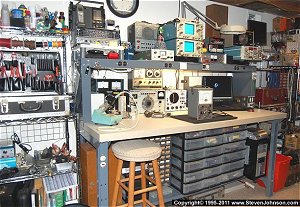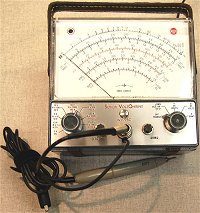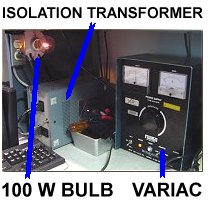Questions are constantly asked about what equipment is needed to repair or restore antique radios and electronics.
Although restorers opinions vary on what's required and what is useful, I will attempt to cover the basics of what I have
found to be required and found useful to test and restore vintage radios.
Note: When viewing larger photos you can use your browsers back button to return to this page.

|
My workbench
Don't think that you need everything you see here on my workbench to get started in this hobby.
I've been acquiring tools and test equipment since I was a kid and although I use just about everything you see here, most of it is not necessary for basic repairs.
Larger Photo
|
The Basics
There are a few items I would recommend to get started and I will describe each here so you may make your own judgment on what to acquire depending on your budget.
Workspace - Hand Tools - Soldering Iron - Meters
Isolation Transformer - Dim Bulb Tester
Workspace
First and foremost is a clear space to work on your projects and store tools and parts.
Although many people work on everything from the kitchen table to the top of their washing machine, having a place to work on a project without picking everything up in
the middle saves time. Having to set up every time you want to continue not only saves time but also helps prevent you from loosing your place and misplacing or mixing up parts.
Everyone is not lucky enough to have the space.
A commercial bench is not required. An old desk or even a door on top of file cabinets will work as long as it's sturdy. A metal surface is not recommended.
A non-conductive surface is better both from a safety standpoint and to prevent the chassis or circuit wiring from making an electrical connection through the bench.
I worked on an old school teacher's desk for many years before splurging on a commercially manufactured electronics bench.
Over the years I've had my electronic workspace in the attic, basement, dining room, and it all started in my bedroom closet when I was growing up.
Lights!!!!! You will want lots of light including at least one work light you can move and aim into cabinets and chassis. I also have a master switch which cuts the power to my entire bench. That way I don't make the mistake of leaving something on.
It's also a kill switch in case of sparks or if I let the smoke out of something.
Parts storage cabinets are useful but if you have room, try not to put them on the bench. Opening drawers when your project is in front of them on the bench can be a pain.
I use carpet sample squares to set my projects on. This allows the radio or chassis to be rotated easily and helps protect the surface of the bench from scratches. You can usually purchase these for a buck or two at a local carpet retailer.
Here is a page about my workbench.
Here is a site with some photos of other workbenches.
You can also view some early radio workbench photos.
If you plan on working on newer static senisitive and surface mount devices you can check out the workbench
I built for working on microelectronics here:
ESD Safe Soldering Work Station
Hand Tools
Hand tools are a must. You will need a set of screwdrivers, flat blade and phillips. A set of nut drivers also comes in handy.
A pair of small wire cutters and needle nose pliers will be used frequently. If you work on test equipment a good small flat blade screwdriver will help loosen those stubborn set screws on knobs.
I recommend an Xcelite #R181. Whatever you get make sure the tip does not flair out to make it wider than the shaft, otherwise it won't fit in the set screw hole.
When you get to the point you want to do alignments on radios you will need a set of plastic Alignment Tools. These are narrow hard plastic screwdriver type tools used to make adjustments.
Metal shaft screwdrivers aren't recommended as they have a tendency to effect the circuit you are trying to adjust.
Soldering Iron
You will need a soldering iron. Most of us wind up with a soldering station and a soldering gun.
A 40-65 watt iron should suit your needs as long as it's a quality iron. Stay away from the cheap import irons.
Soldering can be tedious. A crappy iron can make it even harder.
A soldering gun will be useful for heaver work. If you have to solder and unsolder anything from a chassis, a 100 to 150 watt gun should suffice.
A Weller 8200 soldering gun is a popular model. Used guns are easy to find and with proper care will last for many years.
If you plan on also working on newer circuit boards with surface mount components I suggest you pick up a hot air rework station.
These are combination temperature controlled soldering stations along with a heat gun for removing components. A good basic rework station will cost between $80 and $140.
You can check out some of my collection and what I use here: Soldering Tools Irons and Guns.
Meters
 |
You will need at least one meter. There are three schools of thought on meters, analog, digital, or both.
I use both but to do alignments you will need a good analog meter, preferably a VTVM (Vacuum Tube Volt Meter).
A VTVM has a high input resistance and will not load down the circuit you are trying to adjust. The needle on a analog meter makes it easy to see a peak when doing alignments.
You can find good used VTVM meters at swap meets. Rebuilding and recapping a used VTVM is a good project to start with to get you ready for your first radio repair or restoration.
|
|
A digital meter is easy to read and most now are auto ranging. I use mine for setting power supply voltages and continuity checking more than anything else.
You can pick up a new digital meter made in China for two or three dollars. They work OK but they are garbage and you just toss them if you hit them with too much voltage.
If you can afford a better meter there are many good models for $20 and up. Some even check capacitor values. Fluke meters are pricey but are much more forgiving of operator error.
There are used ones around but due to popularity they still might cost more used than a new medium priced digital meter. If you have the money to invest, a Fluke should give you many years of accurate service.
Isolation Transformer
Many early AC powered radios did not have a power supply section or power transformer.
The tubes were powered directly off the AC line using drop down resistors or power cords that actually had resistance to lower the voltage going to the chassis.
 In some radios the actual chassis had live AC on it depending on which way the plug was put in the wall.
The use of an isolation transformer on your bench to power these older radios you may work on helps prevent shocks since there is no potential between the radio circuit and your bench power or ground. In some radios the actual chassis had live AC on it depending on which way the plug was put in the wall.
The use of an isolation transformer on your bench to power these older radios you may work on helps prevent shocks since there is no potential between the radio circuit and your bench power or ground.
Even if you don't plan on working on any early transformerless sets, the use of an isolation transformer may prevent some mishaps that might occur when working on AC or high voltage circuits.
Opinions vary but you should make sure that both sides of the isolation transformers output (hot and neutral) are not tied to the bench neutral or ground.
If using a three prong outlet on your isolation transformer I recommend the ground pin should be the same as your bench AC ground. This will not have any effect on older radios with a two wire plug.
Dim Bulb Tester or Variac
When you bring your find home it's very tempting to just plug it in and see if it works.
Unfortunately anything 30 years or older more than likely has paper or wax capacitors which dry out with age.
When powered up these capacitors can fail and destroy other components like transformers which can be hard if not impossible to replace.
Worst case would be a fire. Never leave an old radio plugged in and left unattended that has not been rebuilt.
If you must plug in a radio without first replacing all wax and paper capacitors the use of a "Dim Bulb Tester" or a "Varaic" will help prevent these
types of problems by allowing you to bring the voltage up slowly and limit the current draw if there is a problem.
A dim bulb tester is simply an incandescent bulb (NOT CFL or LED) in series with the AC supply. All that's required is a board, a lamp socket to mount on the board, a few incandescent bulbs and an AC cord.
Starting out with a 25 watt bulb limits the current and allows the radio to be brought up in steps as a larger wattage bulb is used.
Recommended bulbs are 25 watts, 40 watts, 60 watts, and 100 watts. I suggest using clear glass bulbs as you can see the filament glow and any sudden changes in the glow
if a component fails. If a component fails the bulb will actually limit the current draw and help avoid more damage to the radio.
You will find more details and plans on how to build a dim bulb tester here.

| A variac is a variable AC supply that allows you to increase the voltage slowly to the unit under test. Some of the better variacs have built in voltage and current meters. Variacs can be expensive so if your budget is small go with a dim bulb tester for starters.
Although I use a variac with built in voltage and current meters, I still have a lamp socket with a 100 watt incandescent bulb in series with it so I can easily see any changes in current draw.
The 100 watt bulb also acts as a built in current limiter in case of a component failure.
|

Other Equipment
Although not necessary for basic repairs, here are a few more items that might make your radio repair and restoration work easier.
Signal Generator - Signal Tracer - Digital Camera - Frequency Counter
Tube Tester - Oscilloscope - Capacitor Tester - Transistor Tester - DC Power Supply
I will be adding descriptions and comments on these items as time permits.
Philip Nelson has put together a good web site on how to get started and what to do with that radio you just picked up and are tempted to plug in.
I strongly suggest you read this first before proceeding:
The Radio Beginner
|




 In some radios the actual chassis had live AC on it depending on which way the plug was put in the wall.
The use of an isolation transformer on your bench to power these older radios you may work on helps prevent shocks since there is no potential between the radio circuit and your bench power or ground.
In some radios the actual chassis had live AC on it depending on which way the plug was put in the wall.
The use of an isolation transformer on your bench to power these older radios you may work on helps prevent shocks since there is no potential between the radio circuit and your bench power or ground.